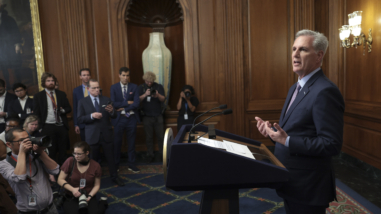James Wallner is a senior fellow at R Street Institute, a nonprofit, nonpartisan, public policy research organization that promotes free markets and limited, effective government. R Street Institute’s work is supported in part by grants from the Hewlett Foundation’s Madison Initiative that seeks to strengthen U.S. democracy and in particular, Congress.
Daniel Stid, director of our Madison Initiative, recently asked Wallner about his counter-intuitive idea that more conflict—early and throughout the legislative process—can help members of Congress better represent their constituents, improve deliberation, and yield stronger legislation.
You’ve suggested the problem with Congress is not that we have too much conflict, but not enough. Could you explain this paradoxical idea?

The conventional wisdom is that Congress is broken because there is too much conflict between its members. That is, members of Congress can’t overcome conflict to find common ground on important issues.
In theory, polarization makes it harder for senators to compromise by increasing the distance between Republicans and Democrats. Senators agree on less and less as that gap widens and the majority goes to greater lengths to avoid negotiating with the minority. Gridlock results when the gap becomes unbridgeable.
Implicit in this is the belief that conflict makes it harder for members to compromise and undermines Congress’s lawmaking capacity. That’s why reform efforts so often focus on preventing conflict as a means to reduce obstruction and end gridlock.
But such efforts assume that conflict and cooperation, or negotiation, cannot coexist. Consequently, they fail to account for what happens in Congress on a regular basis. On closer inspection, it turns out that polarization is not the proximate cause of gridlock. Rather, it is the unwillingness of members to act that is responsible for Congress’s present dysfunction. Gridlock has become the norm in Congress in the absence of any meaningful effort on the part of its members to pass (or defeat) legislation they support (or oppose). Unlike in the past, today’s gridlock results when members of both political parties seek to avoid adjudicating controversial issues publicly.
That Congress can be paralyzed by the mere prospect of disagreement, or conflict, is a testament to the extent of our political dysfunction today. The irony is that our political system was made for conflict.
Fixing Congress and ending gridlock requires members who want to legislate, and changes to how the House and Senate make decisions to create more opportunities for rank-and-file members to influence policy outcomes. Such a prescription will likely strike many as counter-productive given the present nature of our politics. After all, increasing the influence of all members to participate in the legislative process means more conflict, not less. But this kind of conflict can increase Congress’s lawmaking capacity in the current environment.
What makes you optimistic that more open conflict would lead to policy solutions between and among Republicans and Democrats?
The constructive role conflict plays in our politics has been overlooked in recent years because, in part, the legislative process we see today fails to reveal meaningful information about member’s views and preferences during the legislative process. Instead, important information typically remains unknown until the end of the process when party leaders have reached an agreement and changes are no longer permitted to legislation. At that point, the public part of the legislative process begins and is structured in such a way as to ensure the bill’s passage in unaltered form.
Leaders’ motivation for structuring the legislative process in this way is to reduce conflict and make a bill’s passage more likely. Yet, doing so exacerbates conflict at the end of the process and makes gridlock the more likely outcome in all but the most extraordinary circumstances. This kind of legislative process reveals information only to the extent that it generates conflict between its members. As such, viewing conflict as incompatible with compromise denies members—who are operating in an uncertain environment with incomplete information—the feedback they need to successfully negotiate compromises.
Given this, making it easier to negotiate compromises requires reorienting our understanding of the legislative process to account for the vital role played by conflict in facilitating the educational nature of the legislative process. Increasing the information available to leaders, rank-and-file members, their constituents and outside advocacy groups during the consideration of important bills can lead to a healthier Congress; one that can fulfill both its representative and deliberative functions while maintaining its legislative productivity.
What will it take for Congress to adopt this approach? How far away are we from it today?
Contrary to today’s conventional wisdom, an inclusive and deliberative process does not end in chaos. Instead, the rules and procedures governing the legislative process impose order on member interactions and helps them sort through the noise to identify the common policy denominator that becomes the foundation of policy compromise.
To the extent effort is required, gridlock will thus not be the norm because members are less likely to use their parliamentary prerogatives when forced to back up their threats with action. A deliberative process reveals important information about members’ positions and their determination to prevail. Because these can shift over time, members continually refine their expectations of how their opponents will behave over the course of a debate.
Two things have to happen before we witness this new mode of politics in Congress. First, we need to change how we think about legislative deliberation instead of devising ever more clever ways to protect members from the conflict. What we need is not so much the development of a new political science of negotiation or ever-more-intricate rules as it is the revival of an older science of politics that acknowledges the vital role conflict plays in making compromise possible and legitimizing policy outcomes.
Second, the people need to elect members of Congress who are determined to act on their behalf once in office. Given the dynamics of the legislative process, all it takes is a handful of members acting to trigger a reaction from their colleagues. And the action-reaction dynamic is the essence of the legislative process. Once started, it becomes very hard to stop.
This isn’t as hard as it sounds. It’s happened throughout the Congress’s history. In short, we’ve been in this position before. Consider the 1960s and 1970s: At the time, Congress changed how it structured its proceedings to facilitate the participation of interested members in the legislative process. New members, new issues, new technologies, and new advocacy groups forced members in the House and Senate to change how they made decisions. In doing so, they generated more conflict. But that conflict was a necessary precondition for ushering in one of the most productive periods of lawmaking in congressional history.

 Credit: Shutterstock/Gutzemberg
Credit: Shutterstock/Gutzemberg


